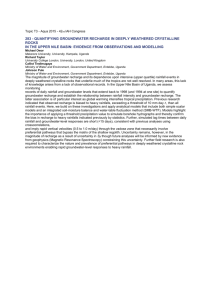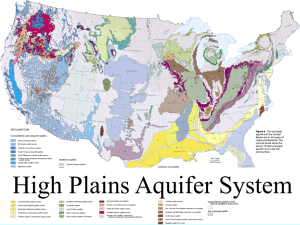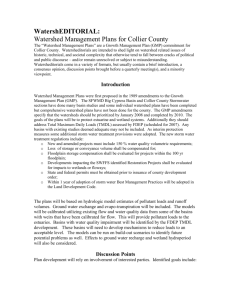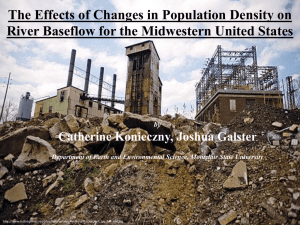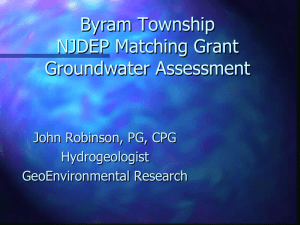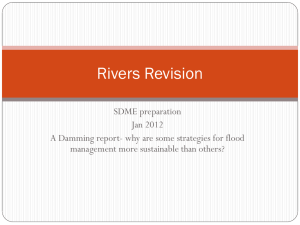Hydrograph analysis and program description
advertisement
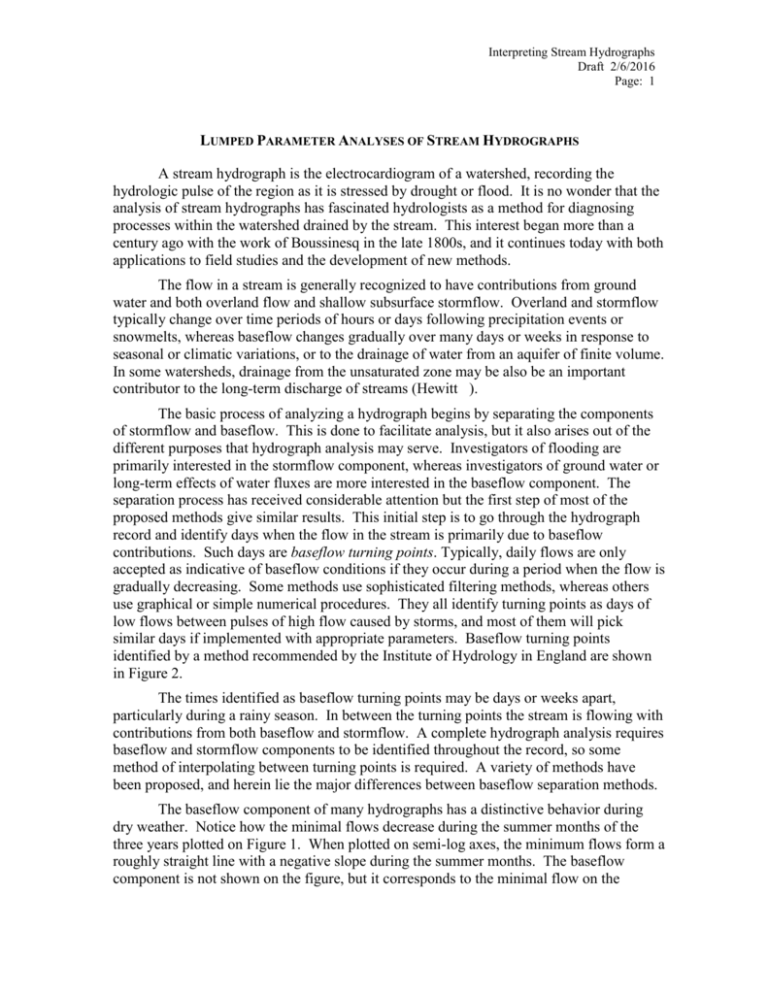
Interpreting Stream Hydrographs Draft 2/6/2016 Page: 1 LUMPED PARAMETER ANALYSES OF STREAM HYDROGRAPHS A stream hydrograph is the electrocardiogram of a watershed, recording the hydrologic pulse of the region as it is stressed by drought or flood. It is no wonder that the analysis of stream hydrographs has fascinated hydrologists as a method for diagnosing processes within the watershed drained by the stream. This interest began more than a century ago with the work of Boussinesq in the late 1800s, and it continues today with both applications to field studies and the development of new methods. The flow in a stream is generally recognized to have contributions from ground water and both overland flow and shallow subsurface stormflow. Overland and stormflow typically change over time periods of hours or days following precipitation events or snowmelts, whereas baseflow changes gradually over many days or weeks in response to seasonal or climatic variations, or to the drainage of water from an aquifer of finite volume. In some watersheds, drainage from the unsaturated zone may be also be an important contributor to the long-term discharge of streams (Hewitt ). The basic process of analyzing a hydrograph begins by separating the components of stormflow and baseflow. This is done to facilitate analysis, but it also arises out of the different purposes that hydrograph analysis may serve. Investigators of flooding are primarily interested in the stormflow component, whereas investigators of ground water or long-term effects of water fluxes are more interested in the baseflow component. The separation process has received considerable attention but the first step of most of the proposed methods give similar results. This initial step is to go through the hydrograph record and identify days when the flow in the stream is primarily due to baseflow contributions. Such days are baseflow turning points. Typically, daily flows are only accepted as indicative of baseflow conditions if they occur during a period when the flow is gradually decreasing. Some methods use sophisticated filtering methods, whereas others use graphical or simple numerical procedures. They all identify turning points as days of low flows between pulses of high flow caused by storms, and most of them will pick similar days if implemented with appropriate parameters. Baseflow turning points identified by a method recommended by the Institute of Hydrology in England are shown in Figure 2. The times identified as baseflow turning points may be days or weeks apart, particularly during a rainy season. In between the turning points the stream is flowing with contributions from both baseflow and stormflow. A complete hydrograph analysis requires baseflow and stormflow components to be identified throughout the record, so some method of interpolating between turning points is required. A variety of methods have been proposed, and herein lie the major differences between baseflow separation methods. The baseflow component of many hydrographs has a distinctive behavior during dry weather. Notice how the minimal flows decrease during the summer months of the three years plotted on Figure 1. When plotted on semi-log axes, the minimum flows form a roughly straight line with a negative slope during the summer months. The baseflow component is not shown on the figure, but it corresponds to the minimal flow on the Interpreting Stream Hydrographs Draft 2/6/2016 Page: 2 hydrograph. As a result, the baseflow component appears to decrease as a negative exponential during the summer months. In South Carolina, the summer months commonly have relatively small amounts of rainfall and evapotranspiration captures much of the rainfall that does occur. As a result, we expect that recharge to the aquifer that discharges to the Little River was 2500 negligible during summer months times 2000 when the baseflow decreased as a negative exponential. These periods of decreasing 1500 baseflow are called baseflow recessions. 1000 We infer that baseflow recessions occur when the recharge is negligible and the 500 aquifer is continuously discharging to the 0 stream. 1600 Discharge (cfs) 1400 1200 1000 800 600 400 200 Rainfall (inch/month x 100) 1800 0 J FMAM J J A SON J FMAM J J A SON J FMAM J J A SON Discharge (cfs) 1600 1400 e7 1200 1000 e6 800 600 e5 400 200 e4 Rainfall (inch/month x 100) 1800 e8 0 J FMAM J J A SON J FMAM J J A SON J FMAM J J A SON Figure 1. Hydrographs and hyetographs from the Little River, SC. for three years. ln (discharge (ft^3/s)) 5 4 3 1-Jan-88 1-Apr-88 1-Jul-88 30-Sep-88 30-Dec-88 Figure 2. Hydrograph with baseflow turning points selected using a simple filtering algorithm (open circles). Baseflow recessions are important to the management of both ground water and surface water resources during drought. The continuously diminishing baseflow during a recession is responsible for the diminishing stream flows during a drought. Understanding the controls of baseflow recession should help to understand to amount and rate of water that is available during a drought. The objective of this analysis is to develop a method for predicting the baseflow to a stream as a function of time and recharge, and hopefully to gain some insight into baseflow recessions. This will allow us to interpolate between baseflow separation points, which will give the baseflow and stormflow components as continuous functions of time. This modest analysis can be extended to provide a method for estimating the major fluxes throughout a watershed as a function of time, which is a remarkable result. CONCEPTUAL MODEL The hydrogeology of nearly any watershed is extremely complicated when viewed in detail. It is possible to assemble a 3-D Interpreting Stream Hydrographs Draft 2/6/2016 Page: 3 model that considers the spatial variations in material properties and processes present in a watershed, and considerable insights can be obtained from this type of model. These are called “distributed parameter” models because values of parameters, like hydraulic conductivity, are distributed and can vary across the model. Distributed parameter models can resemble the geometry of a watershed, and they can provide valuable insights when geometry is important. However, distributed models are time consuming to build and calibrate, and so the insights provided from such a model must be worth the effort of putting it together. An alternative approach is to idealize the watershed as a simplified system that can be characterized using a small number of parameters. The many distributed parameters of the 3-D model are thereby lumped together to form one, or a few, effective parameters in a simplified model whose behavior resembles the actual watershed. This type of simplified analysis is called a “lumped parameter” model. Many of the models that we have described in the previous problems are types of lumped parameter models. R(t) h b A’ x L A A A’ Interpreting Stream Hydrographs Draft 2/6/2016 Page: 4 We will idealize a watershed as a sand-filled tank that is drained by a sand-filled hose held at constant head. This ignores the pattern of streams in the watershed, however, the tank analogy is a simplified approximation of the in the cross section in Figure 2; that is; the tank and sand-filled hose resembles the aquifer that discharges to a nearby stream. The discharge from the hose will decrease as the water level in the tank falls. We will equate the discharge from the hose to the contribution of baseflow to the discharge in a stream. The tank analogy can be justified on more theoretical grounds because the analytical solution for the problem shown in the cross-section consists of an infinite series. The first, and largest, term in the series is the same expression that we will derive for the tank. The higher order terms in the series account for the geometry of the aquifer. The tank is a model of an aquifer with inputs from recharge and outputs from baseflow. The water stored in the aquifer changes when the water level changes. Figure 2. Plan and section views of a simple watershed. R Aw L h baseflow Figure 3. Tank analogy for a watershed. The objective of the analysis is to develop expressions for the average head in an aquifer and the baseflow discharge to a stream as a function of time and recharge. We want to use this analysis to understand baseflow recessions, and to predict the baseflow between any pair of baseflow turning points on a hydrograph. Interpreting Stream Hydrographs Draft 2/6/2016 Page: 5 Translation 1. Rate In The rate of water flowing into the aquifer is Qin = RAw (1) Where Aw is the area of the watershed in plan view. 2. Rate Out The rate being discharged by baseflow is Qout = qoutAa (2) Where Aw is the area of the aquifer along a cross-section parallel to the stream. From Darcy’s Law the baseflow flux is qout = K h L (3) so Qout = KAa h L (4) 3. Rate of change of storage. Water stored in the aquifer is Vw nAw h (5) where n is the specific yield and the rate of change of storage is dVw dh nAw dt dt (6) Substituting (1) (4) and (6) into a volume balance gives RAw KAa dh h nAw L dt (7) rearranging dh R KAa h dt n nAw L Solution Separating variables (8) Interpreting Stream Hydrographs Draft 2/6/2016 Page: 6 dh dt R KAa h n nAw L and integrating nAw L R KAa ln h t Cint KAa n nAw L (9) We will assume that we know the water level at some time and are interested in the water levels after that time, so the initial condition is that h = ho when t = to. This gives nAw L R KAa ln ho Cint KAa n nAw L (10) and substituting into (9) gives R KAa h nAw L n KAa ln t KAa R nAw L ho n nAw L (11) Introducing the lumped parameter a KAa nAw L (12) allows us to simplify R h an at ln R ho an R R h ho e at an an h R 1 e at e at ho aho n (13) This gives the head in the aquifer as a function of time. We can determine the baseflow by substituting (4) into (13) to get ho = QoL/KAa and Interpreting Stream Hydrographs Draft 2/6/2016 Page: 7 Q h Qo ho (14) so from (13) A KR Q R e at 1 e at e at a 1 e at Qo aho n aLQo n (15) where Qbo is the baseflow at t = 0 and Qb is the baseflow after that time. We should introduce another lumped parameter to characterize recharge R* RAa K A R w aLQo n Qo (16) to get Q Qo e at RAw 1 e at (17) or in dimensionless form Q Q* e t* R * 1 e t* Qo (18) Baseflow is given as a function of time and recharge rate by (17) or (18). The response of the system is govern by the value of the watershed recession constant a. We probably should not take the geometric implication of a too literally—clearly the geometry of the aquifer will differ markedly from that of a tank and a hose. Nevertheless, a meaningful interpretation is to consider a as composed of terms related to geometry and terms related to hydrologic properties of the aquifer. This is important because we see that the expression in brackets depends only on the physical characteristics of the aquifer. Often this expression is simplified to a single value, the recession constant (Fetter, 2001). The volume of water that is stored, or that can be released during a recession can be estimated from the analysis above. This type of estimate is important because it allows the volumetric flowrate during a drought to be forecasted. Moreover, the difference between the volume that is stored at the beginning of one recession compared to that from the previous recession is the volume that has been recharged to the aquifer. Assuming the recharge is zero during a recession then (17) reduces to the baseflow during a recession Q Qo e at (18) Interpreting Stream Hydrographs Draft 2/6/2016 Page: 8 Note that the analysis predicts that the baseflow during a recession decreases as a negative exponential of time. Calibration The analysis of baseflow as a function of time can be calibrated by determining a value of a that best predicts hydrograph data from a particular watershed. Perhaps the easiest way to approach this is to determine the semi-log slopes of the recession portions of hydrographs during baseflow recessions. We assume that the recharge is negligible during a recession, so the semi-log slope should be equal to a. In practice the semi-log slopes of different baseflow recessions will vary somewhat, probably because some recharge occurs during recession. The usual practice is to measure the slopes from many recession events and determine the semi-log slope that either best represents these values. Some hydrologists recommend using an average slope, whereas others (like me) prefer that a should be slightly less than the greatest observed slope. In any case, we will assume that a can be obtained from hydrograph data describing recessions. Volume of water in storage The volume of water that could be released from storage in an aquifer will have applications in managing a water supply during drought. We can obtain an estimate for the volume of water that has been discharged from the aquifer from t = 0, the start of the recession, to t = t1 is obtained by integrating (18) t1 V (t1 ) Qo e at dt 0 Qo at e a t1 0 Qo (1 e at1 ) a (19) The maximum volume of water that can be released during the recession occurs when t1=. Vmax Qo a (20) so V (t1 ) Vmax (1 e at1 ) (21) It may be convenient to recast (19) as V (t ) Qo Q Q( t ) 1 (1 e at ) o (1 ) (Qo Q(t )) a a Qo a (22) thereby giving the volume of water released by baseflow at time t in terms of the difference between the initial discharge and the discharge at t. The volume stored in the aquifer that could be released is simply the difference between Vmax and V(t), or Interpreting Stream Hydrographs Draft 2/6/2016 Page: 9 Vstored (t ) Q (t ) a (23) This shows a simple relation between the volume of water stored in an aquifer, the baseflow, and the recession constant. Recharge The recharge rate between any pair of turning points can be estimated by rewriting (17) so that Q = Q1 is the baseflow that occurs at t = t1 Q(t ) Q1e a (t t1 ) RAw 1 e a (t t1 ) (24) Similarly, Q = Q2 is the baseflow that occurs at t = t2. Recharge to the aquifer that occurs from t1 to t2 can be determined by rearranging (24) R1, 2 Q2 Q1e a (t2 t1 ) Aw 1 e a (t2 t1 ) (25) This simple analysis gives the average recharge flux in an aquifer between the times indicated by any pair of turning points, say on Figure 2. Applying (25) sequentially along a hydrograph will allow the recharge to be determined with time. A recharge pulse followed by a recession: superposition in time The analysis given above shows how the baseflow contribution to a stream changes during a recharge event of infinite duration, which is interesting but a bit unrealistic. We can use a simple trick to transform this result to give the baseflow during a recharge event where the recharge is constant and equal to R, followed by a recession event where the recharge is zero. We will assume the recharge event begins at t = 0 and ends at t = t1. During the recharge event, we simply use the original solution in (13). After the recharge even ends, however, the approach is to superimpose two solutions, one for a recharge event of magnitude R that begins at t=0 and is of infinite duration (the solution developed above), and another for a recharge event of magnitude –R that starts at t = t1 and continues indefinitely. R R R t1 t t t1 t Interpreting Stream Hydrographs Draft 2/6/2016 Page: 10 Baseflow for t<t1 Qt t 1 Rs 1 e at (26) and it follows that the baseflow at the end of the recharge period is QR Rs 1 e at1 (27) Baseflow for t>t1, during recession Here we need to superimpose the two analyses. The baseflow due to a recharge event of magnitude –R that starts at t=t1 is obtained directly from (27) Q Rs 1 e ( t * t1 *) (28) Adding (26) and (28) and doing some algebra Qt t1 Rs 1 e at Rs 1 e a ( t t1 ) Qt t1 Rs 1 e at 1 e a ( t t1 ) Qt t1 Rs e at e at1 e at Rs e at (e at1 1) Now multiply by e at1 and rearrange to get e at1 Qt t1 Rs (1 e at1 ) e a ( t t1 ) but according to (27) the term in curly brackets is Qr, the discharge at the start of the recession. The discharge during a recession that begins at t1 is Qt t1 QR e a ( t t1 ) (29) Interpreting Stream Hydrographs Draft 2/6/2016 Page: 11 0.8 1.8 1.6 0.6 1.4 1.2 1 0.4 0.8 0.6 0.2 0.4 0.2 0 0.5 1 1.5 t 2 2.5 3 0 Figure 1. Q* as a function of t* for R*=0.5, 1 and 2. 1 2 t 3 4 Figure 2. Discharge during a recharge event during t*<1 followed by recession. Based on (30). Multiple recharge events of various magnitude Clearly the recharge rate in a basin varies as a function of time. In general, recharge will be equal to precipitation minus interflow and evapotranspiration. We expect that the recharge will probably vary through the year and roughly follow the same trends as rainfall. Often rainfall is expressed as a hyetograph, where the total rainfall over a period is given as an average rate over that period. Thus, we can idealize recharge as a sequence of events of some duration and average magnitude. The analysis above gives the discharge resulting from one such event. We will extend that analysis to consider any number of events. The flux at the end of the first recharge period, t = t2, is q2 R1[1 e a ( t2 t1 ) ] q1e a ( t2 t1 ) (31) The recharge during period 1 has been labeled R1. It follows that the flux during period 2, from t2 < t <t3 is q R2 [1 e a ( t t2 ) ] q2 e a ( t t2 ) (32) but we can substitute (31) to give q R2 [1 e a ( t t2 ) ] R1[1 e a ( t2 t1 ) ] q1e a ( t2 t1 ) e a ( t t2 ) q R2 [1 e a ( t t 2 ) ] R1[e a ( t t 2 ) e a ( t t1 ) ] q1e a ( t t1 ) (33) Interpreting Stream Hydrographs Draft 2/6/2016 Page: 12 Including another recharge interval q R3[1 e a ( t t 3 ) ] q3e a ( t t 3 ) but from (33), the discharge at the end of the second interval (starting the third interval) is q3 R2 [1 e a ( t 3 t 2 ) ] R1[e a ( t 3 t 2 ) e a ( t 3 t1 ) ] q1e a ( t 3 t1 ) Substituting q R3[1 e a ( t t 3 ) ] R2 [1 e a ( t 3 t 2 ) ] R1[e a ( t 3 t 2 ) e a ( t 3 t1 ) ] q1e a ( t 3 t1 ) e a ( t t 3 ) and simplifying q R3 [1 e a(t t3 ) ] R2 [e a(t t3 ) ] e a (t t2 ) ] R1[e a (t t2 ) e a (t t1 ) ] q1e a(t t1 ) It is apparent that the flux can be determine after any number of recharge events simply by adding more terms as in (33). This concept can be implemented as m 1 q (t ) q1e a ( t t2 ) Rm [1 e a ( t tm ] Ri [e a ( t ti 1 ) e a ( t ti ) ] (34) i 1 The first term describes the decay of the initial flow rate as if the recharge that follows is zero. The summation describes the effects of subsequent recharge events of varying magnitude (possibly = 0). The magnitude of the ith recharge event is Ri, and the duration is from ti to ti+1. Eq. (34) assumes that t tm. Getting fancier The analysis above is unable to predict the actual discharge of the stream because it ignores the substantial contribution of interflow or overland flow following rainfall. We could substantially improve our model by including the processes of shallow saturated flow. This would allow us to include the interflow component, and it would also allow us to calculate the recharge using records of rainfall and evapotranspiration, rather than estimating it empirically. A simple water balance on the vadose zone indicates Precipitation = interflow + recharge + change in storage + evapotranspiration P = I + R + S + ET (35) The approach will be to assume that there are two water reservoirs, one shallow and governed by the water balance above, and a deep groundwater system that behaves according to (34). We will use the CSR analogy for the shallow system and develop the analysis the same way that we did for the deep one. The two systems will be coupled together through the recharge. Interflow will be assumed to behave the same as baseflow for the groundwater system. We must use different constants, one for the deep system, Interpreting Stream Hydrographs Draft 2/6/2016 Page: 13 ad, and another for the shallow system, as. Similarly, we will assume that the two systems are characterized by different head, hs and hd. Substituting as before, we change the water balance based on average flux (35) to one based on volumetric flow At s P KAps dh hs R nAt s s At s ET x dt (37) Rainfall ET Recharge hs HR h Interflow b aseflo w x hd baseflow Interpreting Stream Hydrographs Draft 2/6/2016 Page: 14 We will assume that recharge occurs after the head in the shallow system reaches some threshold value, HR. No recharge occurs if hs<HR. Recharge flux will be proportional to (hs - HR) when hs>HR. The volume of water in the tank below HR is the water that can be stored in the vadose zone against gravity drainage. So R0 KApR R ( h HR ) x s I 0 I hs<HR hs>HR hs <H I KApI x (hs H I ) hs >H I (38) Using an similar threshold concept for interflow, and substituting 0 KApI x (hs HI ) KApR x (hs HR ) Sy At s dhs ( ET P) Ats dt (39) solving for the derivative KApI KApR dhs ( ET P) (hs H I ) (hs H R ) dt Sy At s x Sy At s x Sy and grouping terms gives (40) Interpreting Stream Hydrographs Draft 2/6/2016 Page: 15 dhs a a s1 (hs H I ) s 2 (hs H R ) F dt Sy At s Sy At s KAps as1 hs H I x as1 0 as 2 hs<H I KApR hs>H R x as 2 0 F (41) hs<H R ( ET P) Sy Simplifying further dhs Ahs B dt A (a s1 a s 2 ) B a s1 H I a s 2 H R (42) ( ET P) n Note that the interflow response to rainfall is expected to lag behind the actual precipitation recorded at rain gauges due to the travel time from the point where the rain lands in the basin to the point where it is measured at the gauging station. This delay will be included in this model by introducing a lag time, tL, to the precipation record. Accordingly, F(t) = P(t-tL) + ET (t-tL) Where for completeness evapotranspiration is also assume to lag by tL. In any case, it will be assumed that F(t) is constant during a particular time interval. Eq. (42) is separable and the solution is t 1 ln( Ahs B) Cint A (42) 1 ln( Ahs1 B) A (43) hs = hs1 when t = t1 Cint t1 t 1 1 ln( Ahs B) t1 ln( Ahs1 B) A A (44) Interpreting Stream Hydrographs Draft 2/6/2016 Page: 16 At t1 ln( B Ahs ) B Ahs1 B Ahs B Ahs1 e A t t1 hs B B hs1 e A t t1 A A (45) (46) (47) The head in the upper reservoir after time t1 is hs hs B 1 e A t t1 hs1e A t t1 A (48) a s1 H I a s 2 H R RET1 1 e ( as1 as 2 ) t t1 hs1e ( as1 as 2 ) t t1 a s1 a s 2 Application This analysis predicts the effective head in the shallow system as a function of precipitation and ET and four empirical constant; as1 and as2, are rate constants for the drainage of water from the reservoir as recharge or interflow, and HI and HR, are threshold heads for the initiation of interflow and recharge. The area of the basin and the specific yield are also required. The approach is to determine RET from available data. Then use (48) to determine hs. Interflow is determined using I=aIhs, where aI is another constant. Recharge is determined after hs has been found. It is obtained using (38). Baseflow is determined using (30). The total discharge of the stream is Baseflow + Interflow. The analysis is now a function of five constants, as1, as2, aI, HR and ab. aI and As2 are related through the basin area and porosity. This gives a total of 4 constants. Use the record of stream discharge, rainfall and ET to determine constants. Then use eqs. above to determine the baseflow, interflow, recharge and change of water stored in vadose zone as functions of time. Interpreting Stream Hydrographs Draft 2/6/2016 Page: 17 CU HYDROGRAPH CU Hydrograph is a program that implements the analysis outlined above, along with some other analyses to interpret stream hydrographs. The program does hydrograph separation to identify turning points and then it uses several different models for estimating baseflow and recharge from the turning points. At the end of this analysis you have Precipitation, Baseflow, Recharge, Total Streamflow, Stormflow, and Rate of change of storage in the aquifer. ET is estimated using the balance on the vadose zone: ET= Precip- Stormflow-Recharge This completes the major components of the water balance for a watershed. You need data describing total stream flow and precipitation, and the analysis produces an estimate of all the transient fluxes in the watershed. You need to enter flow data from a stream gauging station, and precipitation data to start the analysis. You will also need to enter the correct ranges for the data. Do this by going to Insert-Name-Define and editing the appropriate variables. These variable tell the program where to find the data. Baseflow separation and Segtime Go to the Hydrograph 1 worksheet and do a baseflow separation analysis to distinguish baseflow from total flow. The method described by the Wallingford Institute of Technology is currently implemented in the program, although another slightly different method can be implemented with a small change in the code. Using the baseflow separation routine requires that you specify a segment time, which is the time in days required for the effects of a storm pulse to decay. Pressing the button called “Separate by Institute of Hydrology Method” will divide the hydrograph into segments of length=segment time. Then it determines the lowest flow in each segment. Then it compares each low flow to the low flows in each of the neighboring segments. The idea is that baseflow changes fairly slowly, so the change between one low flow and the neighboring lows will be fairly small if the point represents baseflow. This is implemented by taking 0.9 of the current point and comparing this value to the neighboring lows. The point is recognized as baseflow if the 0.9 value is less than both neighbors. This filtering mechanism seems somewhat arbitrary—the justification for 0.9 is unclear for example. However, the method seems to give reasonable results. Another method can be implemented where baseflow is identified by the slopes between the current point and both the previous and the following points. These slopes are specified by maxup and maxdown on the Hydrograph 1 worksheet. To use this method you need to go into the code and call FilterbySlope instead of FilterbyInstHydro. I tried the FilterbySlope algorithm and it gives results that are similar to FilterbyInstHydro. The program will display all the points that were selected as minimum values in each segment, and it will identify which of those minimum values is baseflow. The points identified as baseflow are called turning points. Adjust the value of segtime and recalculate the baseflow turning points. You need to decide whether the points that are being selected are a reasonable representation of baseflow. Interpreting Stream Hydrographs Draft 2/6/2016 Page: 18 Note that you may need to adjust the ranges on the graph for it to display all, or even part, of the data. Basin Constant The analysis requires selecting a basin constant, called a in the analysis above. The basin constant is a lumped parameter that includes effects related to the size and properties of the watershed. This constant must be determined by the user and there is a worksheet for assisting in this process. The basin constant will be the semi-log slope of the baseflow hydrograph during recession; that is, when the recharge is zero. Many hydrographs have straight sections with a negative slope in dry months, and this is interpreted as recession. The basin constant is determined by obtaining the slope of the line representing recessions. The basin constant will have a significant effect on the results, so it is important to select an appropriate value. I think the most appropriate slope to select here is one that is either equal to, or nearly equal to the steepest negative slope during recession. The reasoning is that any slope that is more positive than that represented by the basin constant will be interpreted by the program as recharge. Picking a that is too small will produce negative recharge, which is inconsistent with the model. The Basin Constant worksheet has space to construct a Master Recession Curve, and it automatically gives some statistics that can be useful in selecting a. A Master Recession Curve is constructed by drawing straight lines representing recessions on a semi-ln hydrograph (this is automatically created in the example). Slide the lines together and determine the slope of the steepest, or nearly the steepest one. Be certain the units are correct. This is one estimate for the Basin Constant. One of the plots gives values of slope determined using different numbers of turning points. The slope steepens as the number of points increases. Another gives these same data as probabilities. Enter the value for the basin constant in Hydrograph1 worksheet. Watershed Area Enter the basin area in ft2 in the Hydrograph1 worksheet. Calculations Before you do the calculations, you should be sure you have entered 1. Segment time 2. Basin Constant 3. Watershed area Now go the the Results by Day worksheet. Press the button to do the calculations. The screen will flash awhile and then the results will be displayed. The plots on this screen are set up to display data from the examples. You probably will have to change the range of the x axis to display your data. The data on this page include the water fluxes estimated on a daily basis. The program has calculated 10 years worth of data, although the display may only show a subset of this information. You can change the amount of daily data written to the screen by modifying the code. Interpreting Stream Hydrographs Draft 2/6/2016 Page: 19 The analysis does calculations assuming that recharge occurs by four possible schedules. Uniform rate between turning points Instantaneous pulse at the first turning point. Instantaneous pulse at the time of the peak in total flow Sinusoidal distribution Probably the actual schedule varies somewhat depending on the details of the precipitation history, and how flow processes are averaged through the watershed. In general, the uniform rate gives the least amount of total recharge and the instantaneous pulse gives the greatest, although the differences are fairly minor. The program interpolates the baseflow between the turning points, and the shape of this curve is noticeably affected by which application schedule you choose. Results by Month Some applications require average values of flux, and these results are calculated in a worksheet called Results by Month. The data include all the monthly averages for all the fluxes. Monthly averages and total averages of fluxes are summarized in the colored boxes at the bottom of the page. Interpreting Stream Hydrographs Draft 2/6/2016 Page: 20 The following are some example sheets from the program. Some instructions about how to use the program are on this worksheet. Enter data here Interpreting Stream Hydrographs Draft 2/6/2016 Page: 21 Then do the hydrograph separation Be sure to enter the Basin Area, as well as the segment length and the Basin Constant. Press the button to calculate the turning points. You may need to adjust the ranges on the graph. Use this worksheet to help determine a Interpreting Stream Hydrographs Draft 2/6/2016 Page: 22 Then go here and press the button to calculate the daily fluxes. A summary of the monthly and yearly fluxes is also calculated. These values could be useful when calibrating numerical models. Interpreting Stream Hydrographs Draft 2/6/2016 Page: 23 This spreadsheet will perform hydrograph separation analyses according to the class notes. It requires input in the form of daily measurements of streamflow and monthly precipitation Put those data in the data worksheet Go to hydrograph 1 worksheet to do a hydrograph separation analysis and to determine a basin constant a, along with the other parameters on the sheet Press the button to revise the hydrograph. Note that a plot of the slopes between each pair of baseflow points is given on the MRC worksheet The program current uses the hydrograph separation method described by the Wallingford Institute of Hydrology Interpreting Stream Hydrographs Draft 2/6/2016 Page: 24 There are graphs on the Basin Constant worksheet that may help you determine a You must enter the time base (segment length), a, and the watershed area on the Hydrograph 1 worksheet After you have determined the time base, a, then go the Results by day worksheet Press the on the Results by day worksheet to calculate and display components of the water balance by day and by m The button on Hydrograph 1 calls a subroutine called Separate to do the baseflow separation The Button on Results by Day calls a subroutine called MainProgram to determine the water balance All subroutines are in Module 1 and all functions are in Module 2 in the attached Vbasic file Note that all the functions to calculate the components of the water balance are accessible and can be used for other Interpreting Stream Hydrographs Draft 2/6/2016 Page: 25 This spreadsheet will perform hydrograph separation analyses according to the class notes. It requires input in the form of daily measurements of streamflow and monthly precipitation Put those data in the data worksheet, Be sure to revise the values representing the ranges of the data Go to hydrograph 1 worksheet to do a hydrograph separation analysis and to determine a basin constant a. You must include the area of the watershed on this spreadsheet Press the button to revise the hydrograph. The program current uses the hydrograph separation method described by the Wallingford Institute of Hydrology There are graphs on the Basin Constant worksheet that may help you determine a You must enter the time base (segment length), a, and the watershed area on the Hydrograph 1 worksheet After you have determined the time base, a, then go the Results by day worksheet Press the on the Results by day worksheet to calculate and display components of the water balance by day and by month The button on Hydrograph 1 calls a subroutine called Separate to do the baseflow separation The Button on Results by Day calls a subroutine called MainProgram to determine the water balance All subroutines are in Module 1 and all functions are in Module 2 in the attached Interpreting Stream Hydrographs Draft 2/6/2016 Page: 26 Vbasic file Note that all the functions to calculate the components of the water balance are accessible and can be used for other calculations

